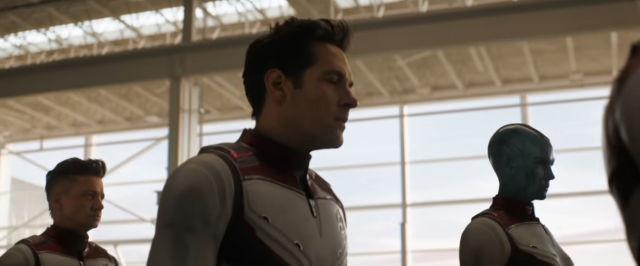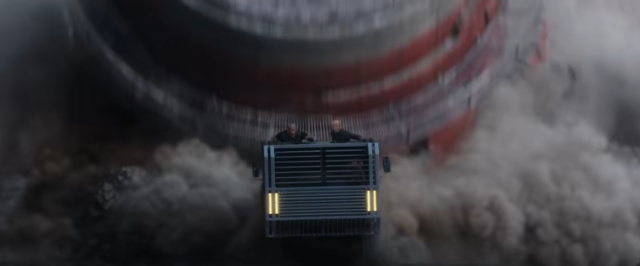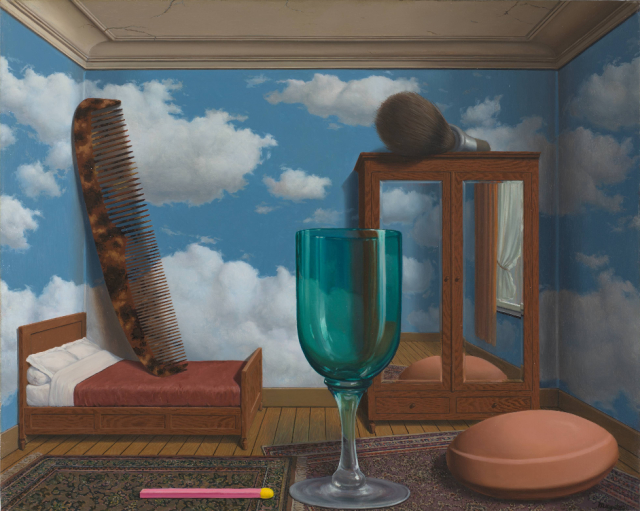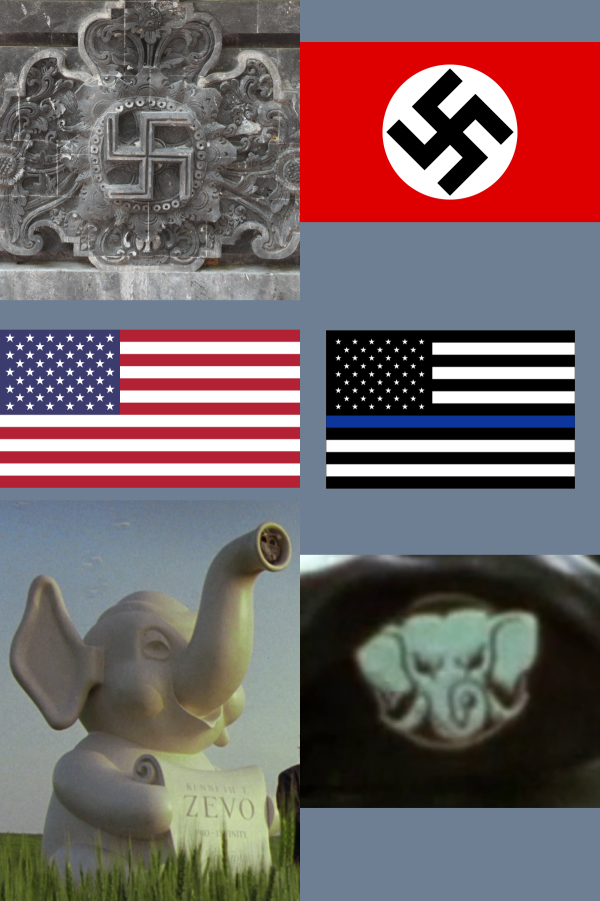Toys was 30 years ahead of its time, and critics hated it
Toys is one of the best movies ever made. Its visual design is apparently inspired by the hyper-real, surreal art of René Magritte. Unlike a Magritte painting, everything in Toys could physically happen. But nobody would spend so lavishly to make the sets of Toys come to life unless they were making a movie.

Toys was a 100 million dollar flop in today’s dollars, and the budget shows.
Despised by critics and almost equally hated by IMDb voters, Toys is more relevant today than ever. The moviegoers of the 90s didn’t know how good they had it. Failing to heed Toys' warning, it was forgotten.
As I visit the movies of the past, a pattern emerges. Maybe it’s nostalgia as a 90s kid, but I feel like the 90s were a golden age of cinematic weirdness. CGI was sometimes present, but it was not so cheap that you could park your actors in front of a green screen and do it all in a computer. If you wanted a shot to look good, you had to think about lights and sets and costumes and everything else. The 1990s had movies like Dick Tracy, Prospero’s Books, Showgirls, the Batman series, Pleasantville, What Dreams May Come, and Dark City. Far from the flat and grey movies of today, each one took color and set design seriously. A single shot from each would clearly belong to each movie. But you can take any blockbuster from the last few years and they all look about the same.
Quick, which recent hit movies are these shots from?




The nicest thing you can say about the aesthetics of these 200 to 400 million dollar movies is that some scenes are visually interesting. Going by the trailers, most of the time they’re in a brown-grey warehouse, or a white tech lab, or a brown-grey dirt road, avoiding a blue collapsing building, that kind of thing. Based on the Avengers: Endgame and Star Wars trailers, Disney has also authorized red as an acceptable color, but only for evil people and while supplies last.
You can’t praise the physical placement of actors and props or the use of light and dark. If these were black and white movies, they wouldn’t stand up against a D-movie1 of the 1930s.

To illustrate this point, here’s a shot from a movie I picked at random. I’ve never even heard of Holiday (1938) until today. This shot won’t win any awards, but at least you can tell what’s going on.

Today’s blockbusters don’t know how to use visuals to convey information. The car fades into the background, and the copter is indistinct.

Meanwhile, a random (and low tier) shot of Toys actually reveals more info in black and white. Notice how the uniform insignia is lit. I would bet money the shoulder of the lying man was intentionally lit with its own light. Without color you still get that the man in the painting is of great importance to the man in bed.
I wouldn’t excuse this uninspired design in a student film, yet these are the most watched, most funded movies we have. The shots I took are from the trailers, the most exciting parts of the movie. Either everyone in live action production forgot how to make a good film, or there’s some focus test somewhere that says your movie will make more money if it’s bland, brown, and grey. Don’t alienate your audience or challenge them at all. Somehow these are the cultural juggernauts we all have to put up with.
Toys is the anti-modern movie. Critics saw it and thought it was too garish. They got their wish; everything is now brown. Captain America fights for justice and in doing so he fights: the Toys characters remain pacifist while still thwarting the villain, reinforcing the message. Far from the nondescript background muzak of today, Toys has distinct theme music and references it constantly.
The music is very 90s. There’s an Enya track and a general world music motif. I believe this was all the rage after Paul Simon’s 1986 album Graceland. (See also: Rusted Root’s Send Me On My Way). Toys is halfway to being a musical too. The fascists have their own fascist beat that might be diegetic.

The Magritte inspiration is clear in shots like this. Compare to the below Magritte painting.

Toys is one of the best looking movies I’ve ever seen. There is a 5 second hallway shot that is used one time in the whole movie, and it’s as bright and cheerful as everything else. It never runs out of ideas. Not only are the massive sets inventive and weird, but the objects in the shot enhance them. There are an endless supply of scenes and jokes that don’t “need” to be in the 2 hour runtime, but make the world more real and make Toys more fun. The premise is more believable the more world-building scenes there are.
Speaking of believable, the CGI is shockingly good for 1991. I watched with 2 animation enthusiasts and some of it is hard to spot. It’s minimal and tasteful.

They played to CGI’s strengths, focusing on a few plastic toys, some computer displays, and a music video. It is either unnoticeable, or noticeably weird (the music video), which works in the story.
Toys is political in ways a lot of blockbusters aren’t. In his master’s thesis, Peter J. Bruno argues that the MCU “perpetuat[es] the myth of the ‘clean war’ through depictions of mass destruction without civilian casualties." Villains are “often portrayed as aspiring conquerors bent on world domination.” Although a surface-level viewing of Toys implies a world-conquering villain as well, there is an intense distrust of the military industrial complex. Bruno and others state that the MCU and other movies are effectively ads for the US military. One need look no further than the military funding blockbusters to explain why every movie loves the US military so much.
In 1992, the relationship between toys and violence was less explicit but perhaps more on people’s minds. The Senate had a hearing on violent video games one year after Toys' release. I don’t think all violent games make you violent, but there are uncomfortable attributes of modern gaming. Game developers gleefully fund real-life weapons makers in exchange for the use of their guns in games. They “must give prior approval to the image or logo in order to protect the brand’s integrity.” Although there are loopholes to licensing, a by-the-books license probably wouldn’t be granted to a game interrogating the trauma of mass shootings or street violence.
Our movies and toys (games) create a fantasy of a “good war”, one where bullets are fired but nobody is hurt and especially none of the good guys. Toys arguably contributes to this delusion; I don’t think anyone dies in it. Still, at least it says these war toys should not exist. Explicitly at times, Toys says that our toys and fantasies should be for “joy and innocence”. If Toys had its way, nobody would play a pretend war because there would be no war. We’d probably still have war even if kids didn’t grow up playing Call of Duty, but it can’t help.
The villain trains unsuspecting kids for war by making video games compatible with real weapons systems. Toys anticipated the drone revolution that came 20 years later. And the kids now old enough to serve in the Navy are right at home piloting death submarines with Xbox controllers. The whole military recruits the next generation of gamer-soldiers on Twitch.
Toys wisely depicts how fascism sneaks into society. It grows like a cancer in the toy factory, repurposing the symbols people know and love and modifying them for the general’s hideous goals. The fascists in Toys remix the “happy worker song” that the factory already had.

Fascist symbols don’t start as fascist. Note the tusks, angry eyes, and curved (defensive?) trunk on the Zevo elephant logo.
There are patches in Toys showing the happy elephant logo, but as far as I can tell, they are never in the foreground. These are not things you consciously notice. They are yet another way the director made Toys feel more lived-in.
I love the movie as it is, but it would have been interesting if the toy designers were repurposed to make mini weapons. The impression in the final cut is that the general sets up manufacturing in the toy factory despite the objections or indifference of the employees. None of them participate. But the more insidious way that military R&D works is that the military funds “apolitical” and “nonviolent” research. Years go by, and either knowingly or unknowingly, you end up with a “Metal Gear launches nukes?" discussion. The robot you saw twerking yesterday is now used by police to assault unhoused people today. There’s nothing political about the technology in an advanced robot. The “apolitical” researchers at Boston Dynamics remind themselves of this as they go to sleep. But how the robot is used is incredibly political, and they don’t care.
LL Cool J is in Toys, and he kills. How amazing a movie is when its rapper-as-comedic-relief throwaway guest star somehow nails all the nuance and humor of the role. LL Cool J, like every other staffer on this movie, never for a second gave less than 100 percent. Robin Williams is at 100, and this is the only movie bigger than he is. He cannot match the energy of Toys, and nobody else would have come close. Toys could have collapsed if a single actor or writer decided to crap on the premise. But everyone takes it seriously and lets the movie speak for itself. A friend pointed out that the villain does not take the whimsy of the toy factory and make it bland. Most movies would have done that. Instead, he is larger than life with his own aggressive, militaristic style. Being larger than life is just a requirement of living in this world.
Bafflingly, Toys is a Christmas movie. Only a few scenes even reference snow, let alone holidays. Don’t worry, I saw it in July and loved it. Even more bafflingly, Toys is rated PG-13. Were people more uptight in the 90s? This was when Bart Simpson saying “eat my shorts” was the height of controversy. I would have almost no issues showing this to a kid. I simply do not understand how Barry Levinson got 100 million dollars to make this movie with a guarantee that half the people that could watch his Christmas movie would be prevented from doing so.
Maybe you missed it, but the movie is called Toys! It’s about toys! It came out on December 18th! Why was this rated PG-13? A few scenes are questionable for their sexuality, but there are like 8 swear words in the whole movie. It’s less scary than Indiana Jones. Maybe the director got a blank check after Rain Man and other hits. The only thing I can think of, and I’m probably wrong, is that Toys was supposed to be PG. Fox needed it out for the 92 Christmas season and there wasn’t enough time to argue with the MPAA. Or maybe they gave him cuts and Barry Levinson wanted to stay true to his vision of an adult movie about toys. I haven’t trolled every corner of the Internet, but some quick searches have not turned up anything about Levinson’s thought process.
Whatever the case, the kids who needed to see Toys did not. The adults who needed to see Toys did not. It was 6th place in its opening weekend, and it only made half its budget back. It completely bombed and was lost to time. Its amazing visual storytelling is a footnote in the careers of the people who made it a masterpiece. Toys is as cutting, honest, colorful, joyous, and subversive as it was in 1992. Maybe now, people can finally see that.
-
To be fair, the list I chose from was biased in favor of popular movies, and the shot I picked was from a YouTube upload - not a random scene. ↩︎